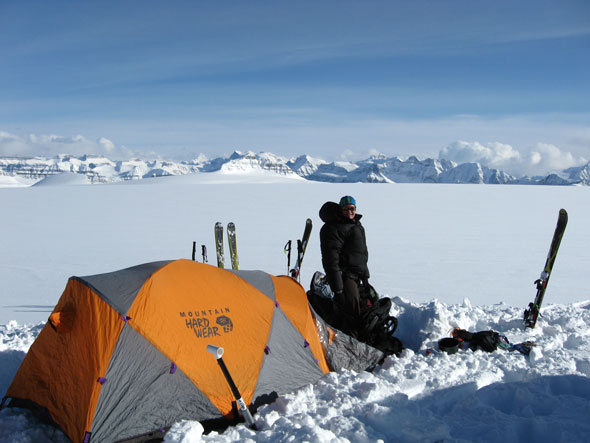Winter activities
Mountain safety
The Canadian Rockies and Selkirk Mountains consist of serious mountain terrain where avalanche hazard is very real for skiers, boarders and ice climbers alike. The most important piece of equipment you’ll ever take into the mountains with you is your brain. The following information will give you the information you need to PLAY SAFE and live to plan your next trip.
Backcountry ski touring and ski mountaineering
Canada’s Mountain National Parks are home to some of the planet’s most spectacular slopes and peaks to explore.
Waterfall ice and mixed climbing
Banff, Yoho, Kootenay, Jasper, and Waterton Lakes are home to many of the finest waterfall ice and mixed ice climbing routes.
Slackcountry / Out of bounds skiing
Before you duck that rope or hike around the backside of a CLOSED sign, do just a little bit of homework.
Equipment checklist for winter backcountry travel
Being well prepared and properly equipped for backcountry travel is essential.

You Are Your Own Safety Monitor!
Before heading into the backcountry, research your trip to be sure you have the skills and experience it will demand of you. Check the Public Avalanche Forecast for the Mountain National Parks you will be visiting, and the Avalanche Terrain Exposure Scale to determine what might be your most appropriate route for the current conditions. Tell someone where you plan to go and when you plan to return. If you are planning a long or hazardous trip and have no friends or family with whom you can leave details, you may choose to complete a Voluntary Safety Registration at the Visitor Information Centre of the Mountain National Park you will be visiting. If you register out, by law, you must register your return to prevent a costly and unnecessary search.
Always take a map, food, water (do not count on finding running water in winter), and extra clothing. If you do find a running creek, be aware that while water in the Mountain National Parks is generally clean, there is always a chance that harmful bacteria or parasites may exist in untreated surface water. Never drink pink “watermelon snow”. Boil and filter untreated water before using, carry purification drops or bring water from a treated source. Don’t go anywhere without your group gear – first aid kit, bivouac sac or small tarp, map and compass and equipment repair kit. Bring your GPS, cell or satellite phone (record emergency numbers), but never expect to count on them 100 per cent of the time.
Beware of all natural hazards; even in winter, mountain lakes and streams present two dangers, drowning and hypothermia in the extremely cold waters. Take precautions when crossing streams, or walking or skiing along the edge of streams and lakes. Be aware of snow bridges that might collapse. Do not venture on glaciated terrain unless everyone in your group is properly equipped and familiar with safe glacier travel and crevasse rescue techniques. Spend some time with your equipment before leaving on your trip - learn how it works, make sure it fits and run through the checklist one more time before leaving home.
Custodial Group Backcountry Travel
Winter Weather
There’s a saying in the mountains – if you don’t like the weather, wait five minutes. In the Mountain National Parks, even during the winter months, you could be slathering on sunscreen and hiding under a sun cap one minute and huddling in your down jacket with your hood tightened around your wind-burned cheeks the next. Generally, temperatures drop as you climb higher into the mountains, but occasionally, a temperature inversion will reverse that rule. Always check the local weather forecast before you venture into the backcountry, and make sure you are prepared for both – and everything in between. The Parks Canada weather data-loggers are weather stations that collect air temperature, wind speed/direction, precipitation, and snow-pack depths at representative sites. The sites are typically in the alpine or near tree-line, which gives the user an idea of what might be developing in avalanche start zones. The Avalanche Forecaster will utilize this data to predict when avalanches may occur, and also to get a better understanding of what is happening with the weather and its trends.

Savvy backcountry travellers dress in layers, which allow you to adjust your body temperature as the weather changes. Try to think of your clothing as a system, with one piece complementing the other. Always pack an extra warm layer just in case, a mishap as seemingly innocuous as a sprained knee or ankle will very quickly bring your day to a grinding halt – and your ability to generate body heat by moving. Always pack clothing that will protect you from wind, rain, cold and snow, and also sunglasses and goggles to protect your eyes from harmful UV rays that are extra damaging when reflected off the snow at higher elevations. For help deciding what items to never leave home without, check out the Winter Backcountry Checklist. Generally speaking, the climate in Glacier National Park is milder and wetter than the Rocky Mountains, which tend to be drier with temperatures at times dropping to extremes lows.
Pets
Pets are permitted on hiking trails but must be on a leash at all times. Know that dogs and other pets may jeopardize your safety and theirs by provoking and attracting wildlife. Bears, cougars, porcupines, coyotes, wolverines and small predators such as martens and fishers are all capable of injuring or even killing your pet.
- Date modified :